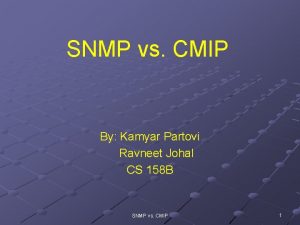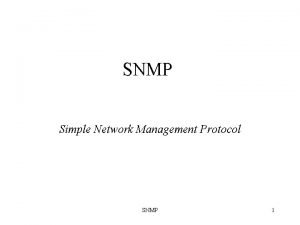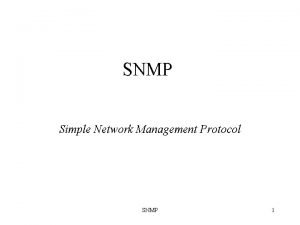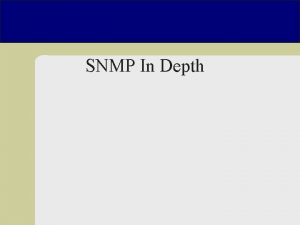SNMP Monitoring with Kaseya IT Managed Services Defined















- Slides: 15

SNMP Monitoring with Kaseya IT Managed Services Defined

Course Overview • • Uploading MIBs and OIDs Creating SNMP Monitor Sets Assigning SNMP Monitor Sets Reporting on SNMP

Lesson Overview • • Introduction to Kaseya SNMP Monitoring Introduction to MIB’s and OID’s Uploading MIB’s to Kaseya Adding OID’s to the Kaseya Monitor List

Kaseya SNMP Monitoring SNMP Manager SNMP Enabled Device Five Basic SNMP Messages • • • GET-NEXT GET-RESPONSE SET TRAP Only the TRAP message is generated by the SNMP device

Kaseya SNMP Monitoring • An agent installed on a managed machine will contact the SNMP enabled Device using an SNMP Polling message (such as SNMPGet). • The Agent will then collect the data from the device and report it to your Kaseya server. • The Kaseya server will record the data in the VSA database tables for reporting and alert a predefined thresholds.

Introduction to MIB’s and OID’s • All SNMP events (traps), names, data, etc. are assigned a unique Object ID number (OID) in the Management Information Base (MIB). • This number is assigned by www. iana. org (Internet Assigned Numbers Authority) • The OID will form a unique identifier fore each event, name, or data element.

Introduction to MIB’s and OID’s • The OID numbers will form an OID tree.

Introduction to MIB’s and OID’s • Fore example, Cisco would fall under iso. org. dod. internet. private. enterprises. Cisco • This translates to 1. 3. 6. 1. 4. 1. 9 • Each of the Cisco Systems unique event, name, or data elements would build up this number. • The MIB translates the OID numbers to plan language.

Uploading MIB’s to Kaseya • The MIB associates each OID with a readable label and various other parameters related to the object. • The MIB then serves as a data dictionary or code book that is used to assemble and interpret SNMP messages. • For the Agent to collect data and report it you must locate and upload the device MIB or create one by doing an SNMP Walk.

Lesson Overview • • Creating and Editing SNMP Monitor Sets. Define collection operators. Define collection and alarm thresholds. Time out and re-alarm duration.

Lesson Overview • Prepare an agent for SNMP monitoring • Conduct a LAN Scan • Assign The Community Password. • Assign SNMP monitor set to the agent. • Set alarm actions.

Monitoring SNMP A system with a Kaseya Agent installed will query the SNMP enable devices and store the information defined in the SNMP Monitor Set locally.

Monitoring SNMP The Monitoring system will then transmit the SNMP data to the Kaseya server to record in the Server Database.

Monitoring SNMP If any of the Data elements are beyond the established alarm threshold set in the Monitor Set, the Kaseya server will alarm.

Lesson Overview • Reviewing SNMP Monitor Logs. • Creating SNMP Monitor set reports.
 What is the collection of well defined objects
What is the collection of well defined objects Managed services proposal ppt
Managed services proposal ppt Managed desktop services
Managed desktop services Managed services hertfordshire
Managed services hertfordshire Managed services hospitality industry
Managed services hospitality industry Enavate
Enavate Kaseya cos'è
Kaseya cos'è Kaseya procedures
Kaseya procedures Kaseya kes
Kaseya kes Kaseya virtual system administrator
Kaseya virtual system administrator Dedicated defined benefit services llc
Dedicated defined benefit services llc Kaye putnam quiz
Kaye putnam quiz Ravneet johal
Ravneet johal Snmpv
Snmpv Snmp model in computer networks
Snmp model in computer networks Udp 161
Udp 161




























